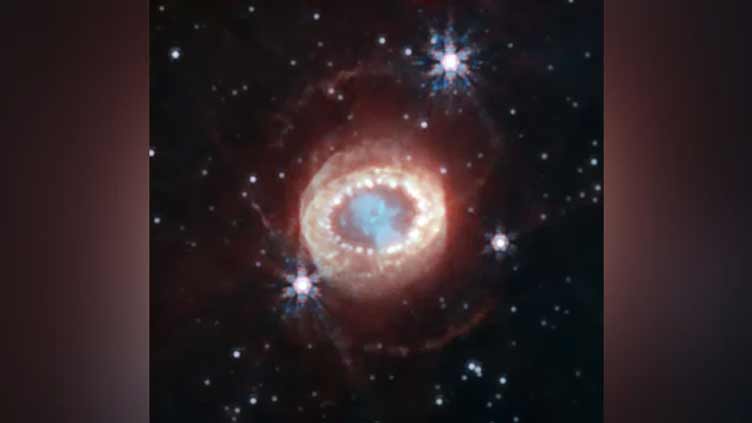What a dying star looks like - James Webb Telescope tells us

Technology
Dying star appears to be a necklace surrounded by emitted material of gas, and dust
(Web Desk) - Glorious photos of a fading star SN1987A which turned supernova in 1987 - the closest and brightest star explosion seen from Earth - were released on Thursday.
In the capture it emerges that dying star appears to be a necklace surrounded by emitted material of gas, and dust including two pearls earlier not detected by the European Hubble Space Telescope.
The new revelation — at a distance of 170,000 light-years — has allowed astronomers to dive deep into the life cycles of stars and the pattern of their death. This supernova in the Southern hemisphere of the sky is the most observed celestial object in space.
The image shows a series of luminous rings that represent bands of gas and dust pushed out by SN1987A in its various stages of death since it was excited and illuminated by the expanding shockwaves emanating in the last moment of the collapse and going supernova.
According to the scientists, one of these rings is a string of pearls, which comprises material ejected about 20,000 years before the final occurrence.
Floating like a cosmic jellyfish is the iconic supernova SN 1987A.
— NASA Webb Telescope (@NASAWebb) August 31, 2023
Webb has given us the most clear & detailed look yet, revealing a new feature — small crescent-like structures thought to be part of the outer layers of gas shot out from the explosion: https://t.co/IJJAfRDXHG pic.twitter.com/6Ct8T7EiMx
It became possible through the James Webb Space Telescope which provided a clear view till date of the necklace and the diffusing brightness surrounding the star.
"We're able to see new hotspots emerging outside the ring that has previously been illuminated," Dr Roger Wesson from Cardiff University, UK told BBC News.
"In addition, we see emission from molecular hydrogen in the ring that was not necessarily expected and something only JWST could have revealed with its superior sensitivity and resolution," he added.
New features that came to the fore by James Webb are the crescents or arcs of emission inside the cosmic jewellery necklace but just outside the dense inner area that looks a little like a keyhole.
"We don't really understand the crescents yet," lead analyst Dr Mikako Matsuura said, adding that "this material could be being illuminated by some kind of reverse shock — a shock coming back towards the keyhole."
Despite its potency, JWST cannot see the remnants of the dying star that are buried somewhere in the dense dust field. Those remnants should be compact objects made up of neutron particles and measuring just a few tens of kilometres across.
Since the star went supernova, every large telescope that can see SN1987A has observed and studied its evolution and other features.
While tracing the causes, astronomers believe that the star was hot, relatively young, probably 20 to 30 times as massive as our Sun.
Dr Wesson said: "One of the mysteries of this star is that it exploded when it was a blue supergiant when at the time all the theories said only red supergiant stars could explode. So unravelling that mystery has been one of the great quests."
"The indications are that Webb will be operational much longer than originally envisaged — maybe 20 years — and that will give us a very powerful tool to keep on monitoring SN1987A to see how it is changing."


